Periodic Microstructures Fabricated by Laser Interference with Subsequent Etching
Abstract
1. Introduction
2. Materials and Methods
3. Results and Discussion
4. Conclusions
Author Contributions
Funding
Conflicts of Interest
References
- Zhang, A.; Liu, B.; Liu, S.; Li, M.; Zheng, W.; Deng, L.; Liu, J. Novel approach to immobilize Au nanoclusters on micro/nanostructured carbonized natural lotus leaf as green catalyst with highly efficient catalytic activity. Chem. Eng. J. 2019, 371, 876–884. [Google Scholar] [CrossRef]
- Huang, J.; Wang, X.; Wang, Z.L. Controlled replication of butterfly wings for achieving tunable photonic properties. Nano Lett. 2006, 6, 2325–2331. [Google Scholar] [CrossRef] [PubMed]
- Quan, B.; Yao, Z.; Sun, W.; Liu, Z.; Xia, X.; Gu, C.; Li, J. Fabrication of inverted pyramidal pits with Nano-opening by laser interference lithography and wet etching. Microelectron. Eng. 2016, 163, 110–114. [Google Scholar] [CrossRef]
- Zhao, D.; Gao, N.; Jia, R.; Zhang, L.; Yan, W.; Liu, D. Photoresistless fabrication of periodic patterns on GaAs by laser interference photochemical lithography. RSC Adv. 2016, 6, 44057–44061. [Google Scholar] [CrossRef]
- Capretti, A.; Ringsmuth, A.K.; van Velzen, J.F.; Rosnik, A.; Croce, R.; Gregorkiewicz, T. Nanophotonics of higher-plant photosynthetic membranes. Light Sci. Appl. 2019, 8, 5. [Google Scholar] [CrossRef]
- Chen, S.S.; Chen, J.F.; Zhang, X.D.; Li, Z.Y.; Li, J.F. Kirigami/origami: Unfolding the new regime of advanced 3D microfabrication/nanofabrication with “folding”. Light Sci. Appl. 2020, 9, 75. [Google Scholar] [CrossRef]
- Mao, A.; Li, Y.; Wang, G.; Li, P. The fabrication of hydrophilic structure on lens via direct laser interference lithography. Optik 2017, 149, 90–94. [Google Scholar] [CrossRef]
- Aguilar-Morales, A.I.; Alamri, S.; Lasagni, A.F. Micro-fabrication of high aspect ratio periodic structures on stainless steel by picosecond direct laser interference patterning. J. Mater. Process. Tech. 2018, 252, 313–321. [Google Scholar] [CrossRef]
- Nozaki, K.; Shinonaga, T.; Ebe, N.; Horiuchi, N.; Nakamura, M.; Tsutsumi, Y.; Hanawa, T.; Tsukamoto, M.; Yamashita, K.; Nagai, A. Hierarchical periodic micro/nano-structures on nitinol and their influence on oriented endothelialization and anti-thrombosis. Mat. Sci. Eng. C-Mater. 2015, 57, 1–6. [Google Scholar] [CrossRef]
- Jeon, Y.; Choi, H.R.; Kwon, J.H.; Choi, S.; Nam, K.M.; Park, K.C.; Choi, K.C. Sandwich-structure transferable free-form OLEDs for wearable and disposable skin wound photomedicine. Light Sci. Appl. 2019, 8, 114. [Google Scholar] [CrossRef]
- Zhang, X.L.; Song, J.F.; Li, X.B.; Feng, J.; Sun, H.B. Optical Tamm states enhanced broad-band absorption of organic solar cells. Appl. Phys. Lett. 2012, 101, 243901. [Google Scholar] [CrossRef]
- Bi, Y.G.; Feng, J.; Li, Y.F.; Zhang, X.L.; Liu, Y.F.; Jin, Y.; Sun, H.B. Broadband light extraction from white organic light-emitting devices by employing corrugated metallic electrodes with dual periodicity. Adv. Mater. 2013, 25, 6969–6974. [Google Scholar] [CrossRef] [PubMed]
- Ma, Z.; Jiang, C.; Li, X.; Ye, F.; Yuan, W. Controllable fabrication of periodic arrays of high-aspect-ratio micro-nano hierarchical structures and their superhydrophobicity. J. Micromech. Microeng. 2013, 23, 095027. [Google Scholar] [CrossRef]
- Wu, D.; Wang, J.N.; Wu, S.Z.; Chen, Q.D.; Zhao, S.; Zhang, H.; Sun, H.B.; Jiang, L. Three-level biomimetic rice leaf surfaces with controllable anisotropic sliding. Adv. Funct. Mater. 2011, 21, 2927–2932. [Google Scholar] [CrossRef]
- Yi, P.; Zhang, C.; Peng, L.; Lai, X. Flexible silver-mesh electrodes with moth-eye nanostructures for transmittance enhancement by double-sided roll-to-roll nanoimprint lithography. RSC Adv. 2017, 7, 48835–48840. [Google Scholar] [CrossRef]
- Pisco, M.; Galeotti, F.; Quero, G.; Grisci, G.; Micco, A.; Mercaldo, L.V.; Veneri, P.D.; Cutolo, A.; Cusano, A. Nanosphere lithography for optical fiber tip nanoprobes. Light Sci. Appl. 2017, 6, e16229. [Google Scholar] [CrossRef]
- Zhang, F.; Nie, Z.; Huang, H.; Ma, L.; Tang, H.; Hao, M.; Qiu, J. Self-assembled three-dimensional periodic micro-nano structures in bulk quartz crystal induced by femtosecond laser pulses. Opt. Express 2019, 27, 6442–6450. [Google Scholar] [CrossRef]
- Malinauskas, M.; Zukauskas, A.; Hasegawa, S.; Hayasaki, Y.; Mizeikis, V.; Buividas, R.; Juodkazis, S. Ultrafast laser processing of materials: From science to industry. Light Sci. Appl. 2016, 5, e16133. [Google Scholar] [CrossRef]
- Liao, Y.; Pan, W.J.; Cui, Y.; Qiao, L.L.; Bellouard, Y.; Sugioka, K.; Cheng, Y. Formation of in-volume nanogratings with sub-100-nm periods in glass by femtosecond laser irradiation. Opt. Lett. 2015, 40, 3623–3626. [Google Scholar] [CrossRef]
- Wu, D.; Wu, S.Z.; Niu, L.G.; Chen, Q.D.; Wang, R.; Song, J.F.; Fang, H.H.; Sun, H.B. High numerical aperture microlens arrays of close packing. Appl. Phys. Lett. 2010, 97, 031109. [Google Scholar] [CrossRef]
- Zhang, Y.L.; Chen, Q.D.; Xia, H.; Sun, H.B. Designable 3D nanofabrication by femtosecond laser direct writing. Nano Today 2010, 5, 435–448. [Google Scholar] [CrossRef]
- Wu, D.; Chen, Q.D.; Niu, L.G.; Wang, J.N.; Wang, J.; Wang, R.; Xia, H.; Sun, H.B. Femtosecond laser rapid prototyping of nanoshells and suspending components towards microfluidic devices. Lab Chip. 2009, 9, 2391–2394. [Google Scholar] [CrossRef] [PubMed]
- Xu, B.B.; Zhang, Y.L.; Xia, H.; Dong, W.F.; Ding, H.; Sun, H.B. Fabrication and multifunction integration of microfluidic chips by femtosecond laser direct writing. Lab Chip. 2013, 13, 1677–1690. [Google Scholar] [CrossRef] [PubMed]
- Yong, J.L.; Chen, F.; Fang, Y.; Huo, J.L.; Yang, Q.; Zhang, J.Z.; Bian, H.; Hou, X. Bioinspired Design of Underwater Superaerophobic and Superaerophilic Surfaces by Femtosecond Laser Ablation for Anti- or Capturing Bubbles. ACS Appl. Mater. Interfaces. 2017, 9, 39863–39871. [Google Scholar] [CrossRef] [PubMed]
- Guo, L.; Zhang, Y.L.; Shao, R.Q.; Xie, S.Y.; Wang, J.N.; Li, X.B.; Jiang, F.; Jiang, H.B.; Chen, Q.D.; Zhang, T.; et al. Two-beam-laser interference mediated reduction, patterning and nanostructuring of graphene oxide for flexible humidity sensing device. Carbon 2012, 50, 1667–1673. [Google Scholar] [CrossRef]
- Wu, J.; Geng, Z.X.; Xie, Y.Y.; Fan, Z.Y.; Su, Y.; Xu, C.; Chen, H.D. The fabrication of nanostructures in polydimethylsiloxane by laser interference lithography. Nanomaterials 2019, 9, 73. [Google Scholar] [CrossRef]
- Mulko, L.E.; Rossa, M.; Aranguren-Abrate, J.P.; Pino, G.A. Micropatterning of fluorescent silver nanoclusters in polymer films by Laser Interference. Appl. Surf. Sci. 2019, 485, 141–146. [Google Scholar] [CrossRef]
- Wang, L.; Xu, B.B.; Chen, Q.D.; Ma, Z.C.; Zhang, R.; Liu, X.Q.; Sun, H.B. Maskless laser tailoring of conical pillar arrays for antireflective biomimetic surfaces. Opt. Lett. 2011, 36, 3305–3307. [Google Scholar] [CrossRef]
- Pan, A.; Si, J.; Chen, T.; Li, C.; Hou, X. Fabrication of two-dimensional periodic structures on silicon after scanning irradiation with femtosecond laser multi-beams. Applied. Surf. Sci. 2016, 368, 443–448. [Google Scholar] [CrossRef]
- Stankevicius, E.; Garliauskas, M.; Raciukaitis, G. Bessel-like beam array generation using round-tip microstructures and their use in the material treatment. J. Laser Micro. Nanoen. 2016, 11, 352–356. [Google Scholar]
- Stankevicius, E.; Garliauskas, M.; Gedvilas, M.; Raciukaitis, G. Bessel-like beam array formation by periodical arrangement of the polymeric tound-tip microstructures. Opt. Express 2015, 23, 28556–28566. [Google Scholar] [CrossRef] [PubMed]
- Gedvilas, M.; Voisiat, B.; Indrisiunas, S.; Raciukaitis, G.; Veiko, V.; Zakoldaev, R.; Sinev, D.; Shakhno, E. Thermo-chemical microstructuring of thin metal films using multi-beam interference by short (nano- & picosecond) laser pulses. Thin Solid Films 2017, 634, 134–140. [Google Scholar]
- Molotokaite, E.; Gedvilas, M.; Raciukaitis, G.; Girdauskas, V. Picosecond laser beam interference ablation of thin metal films on glass substrate. J. Laser Micro. Nanoen. 2010, 5, 74–79. [Google Scholar] [CrossRef]
- Indrisiunas, S.; Voisiat, B.; Gedvilas, M.; Raciukaitis, G. New opportunities for custom-shape patterning using polarization control in confocal laser beam interference setup. J. Laser Appl. 2017, 29, UNSP 011501. [Google Scholar] [CrossRef]
- Lasagni, A.F.; Roch, T.; Langheinrich, D.; Bieda, M.; Wetzig, A. Large area direct fabrication of periodic arrays using interference patterning. In Proceedings of the Physics Procedia, 6th International WLT Conference on Lasers in Manufacturing (LiM), Munich, Germany, 23–26 May 2011; Schmidt, M., Zaeh, M.F., Graf, T., Ostendorf, A., Eds.; Elsevier: Dresden, Germany, 2011. [Google Scholar]
- Hu, Y.; Wang, Z.; Weng, Z.; Yu, M.; Wang, D. Bio-inspired hierarchical patterning of silicon by laser interference lithography. Appl. Optics 2016, 55, 3226–3232. [Google Scholar] [CrossRef] [PubMed]
- Huerta-Murillo, D.; Aguilar-Morales, A.I.; Alamri, S.; Cardoso, J.T.; Jagdheesh, R.; Lasagni, A.F.; Ocana, J.L. Fabrication of multi-scale periodic surface structures on Ti-6Al-4V by direct laser writing and direct laser interference patterning for modified wettability applications. Opt. Lasers Eng. 2017, 98, 134–142. [Google Scholar] [CrossRef]
- Zhao, L.; Wang, Z.; Zhang, J.; Yu, M.; Li, S.; Li, D.; Yue, Y. Effects of laser fluence on silicon modification by four-beam laser interference. J. Appl. Phys. 2015, 118, 23. [Google Scholar] [CrossRef]
- Santybayeva, Z.; Meghit, A.; Desgarceaux, R.; Teissier, R.; Pichot, F.; de Marin, C.; Charlot, B.; Pedaci, F. Fabrication of quartz microcylinders by laser interference lithography for angular optical tweezers. J. Micro-Nanolith. Mem. 2016, 15, 034507. [Google Scholar] [CrossRef][Green Version]
- Lin, T.H.; Yang, Y.K.; Fu, C.C. Integration of multiple theories for the simulation of laser interference lithography processes. Nanotechnology 2017, 28, 475301. [Google Scholar] [CrossRef] [PubMed]
- Qi, H.F.; Wang, Q.P.; Zhang, X.Y.; Liu, Z.J.; Zhang, S.J.; Chang, J.; Xia, W.; Jin, G.F. Theoretical and experimental study of laser induced damage on GaAs by nanosecond pulsed irradiation. Opt. Laser Eng. 2011, 49, 285–291. [Google Scholar] [CrossRef]
- Gedvilas, M.; Indrisiunas, S.; Voisiat, B.; Stankevicius, E.; Selskis, A.; Raciukaitis, G. Nanoscale thermal diffusian during the laser interference ablation using femto-, pico-, and nanosecond pulses in silicon. Phys. Chem. Chem. Phys. 2018, 20, 12166–12174. [Google Scholar] [CrossRef] [PubMed]
- Liu, X.Q.; Yang, S.N.; Yu, L.; Chen, Q.D.; Zhang, Y.L.; Sun, H.B. Rapid Engraving of Artificial Compound Eyes from Curved Sapphire Substrate. Adv. Funct. Mater. 2019, 29, 1900037. [Google Scholar] [CrossRef]
- Liu, X.Q.; Yu, L.; Yang, S.N.; Chen, Q.D.; Wang, L.; Juodkazis, S.; Sun, H.B. Optical Nanofabrication of Concave Microlens Arrays. Laser Photonics Rev. 2019, 13, 1800272. [Google Scholar] [CrossRef]
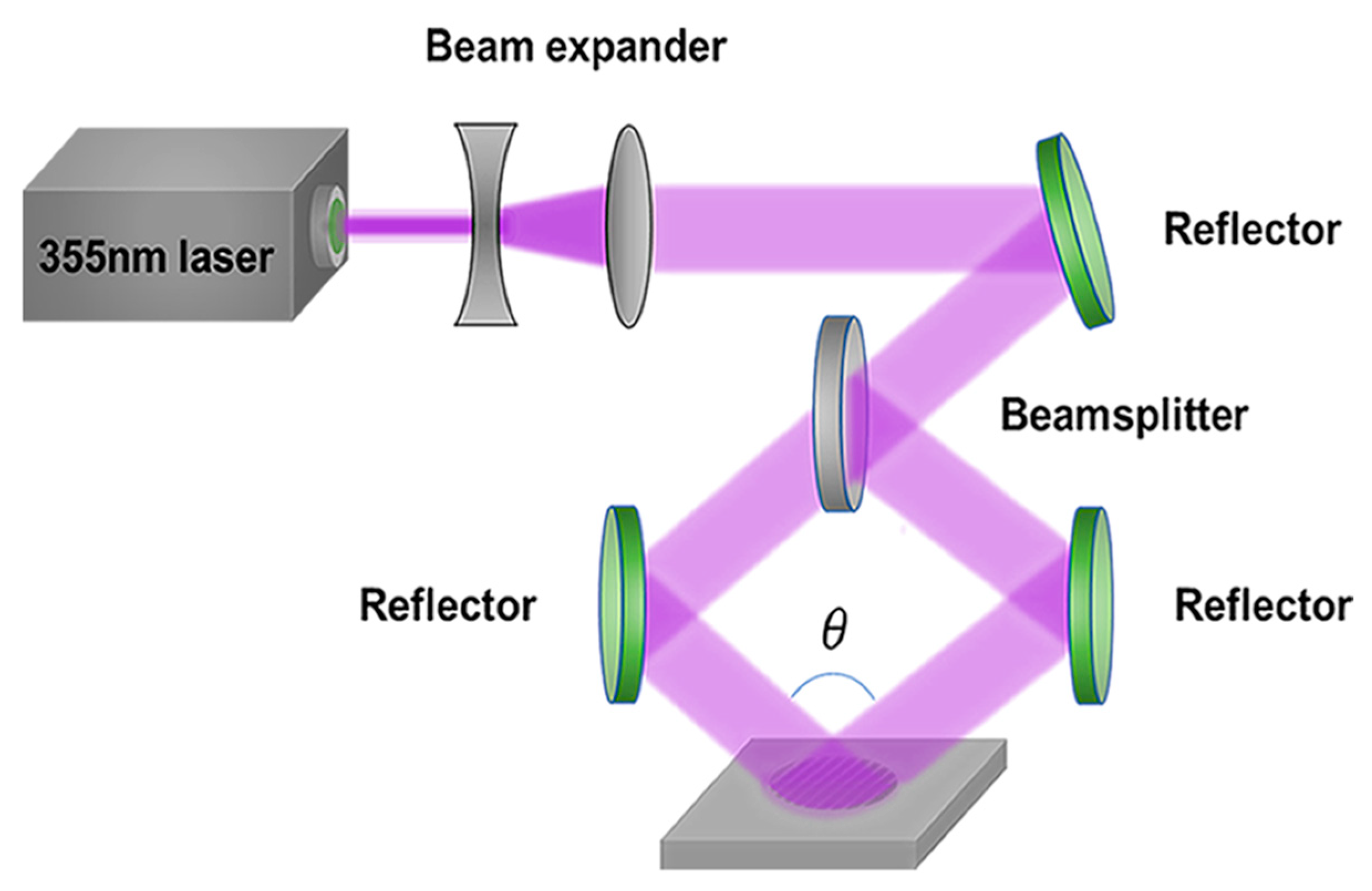
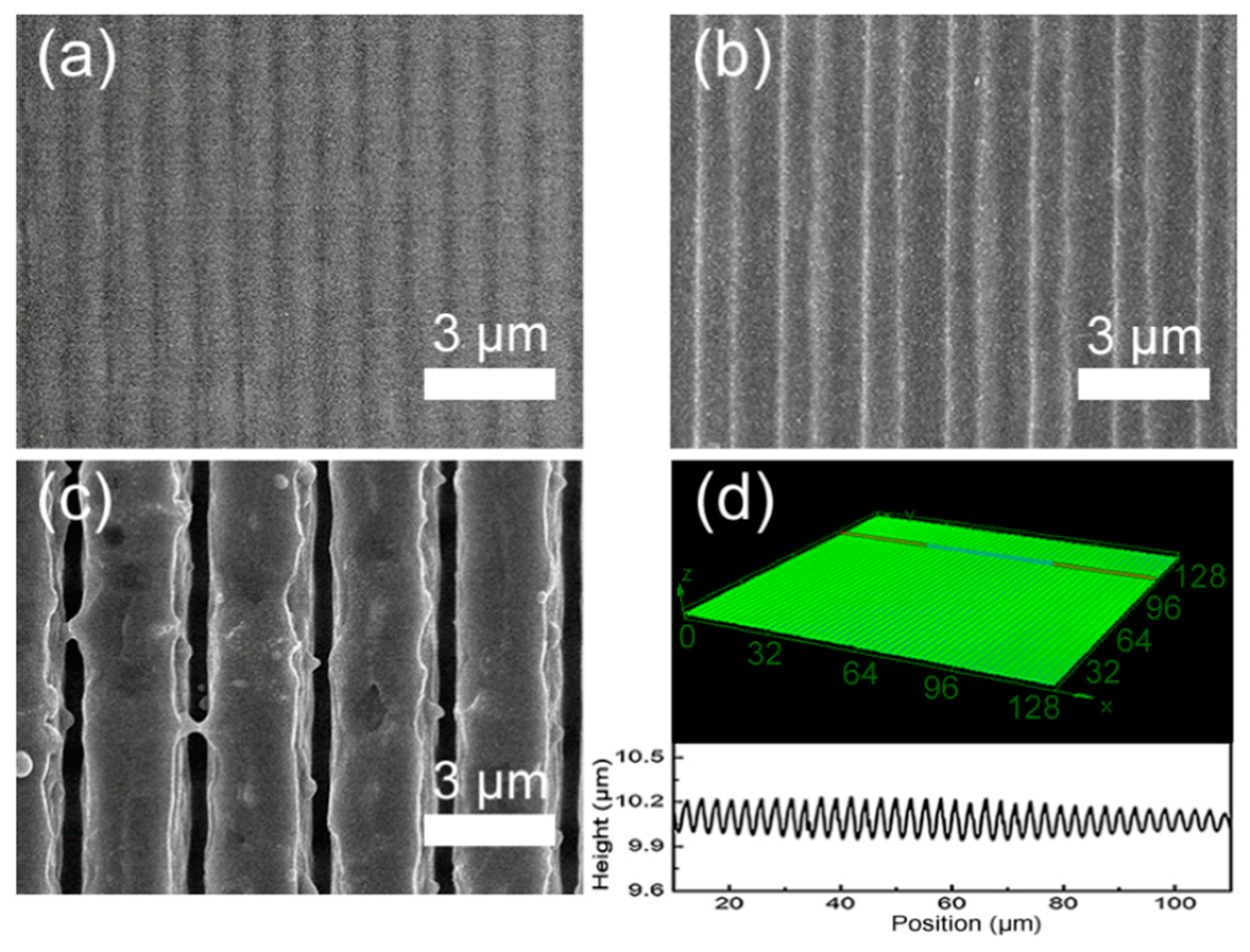
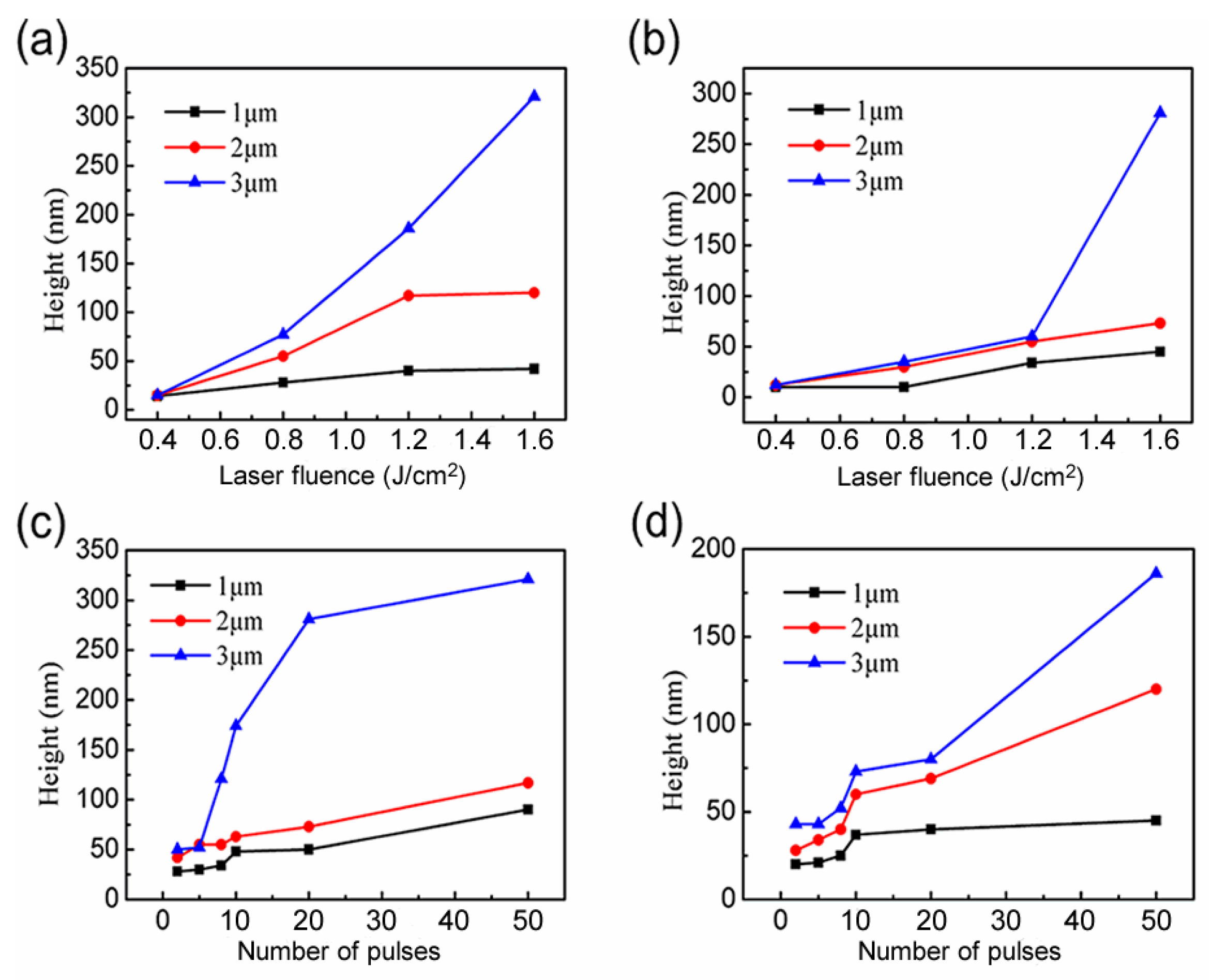
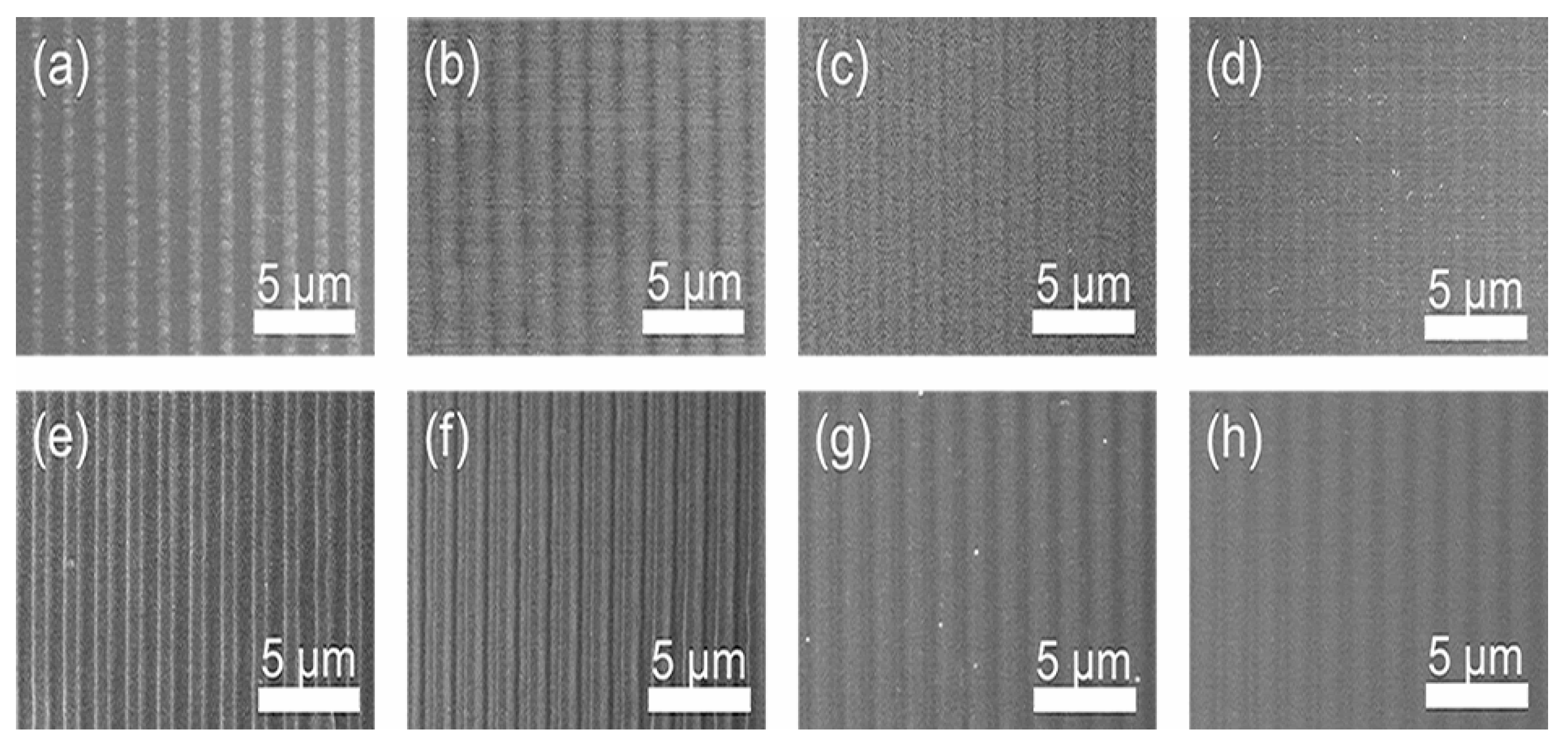

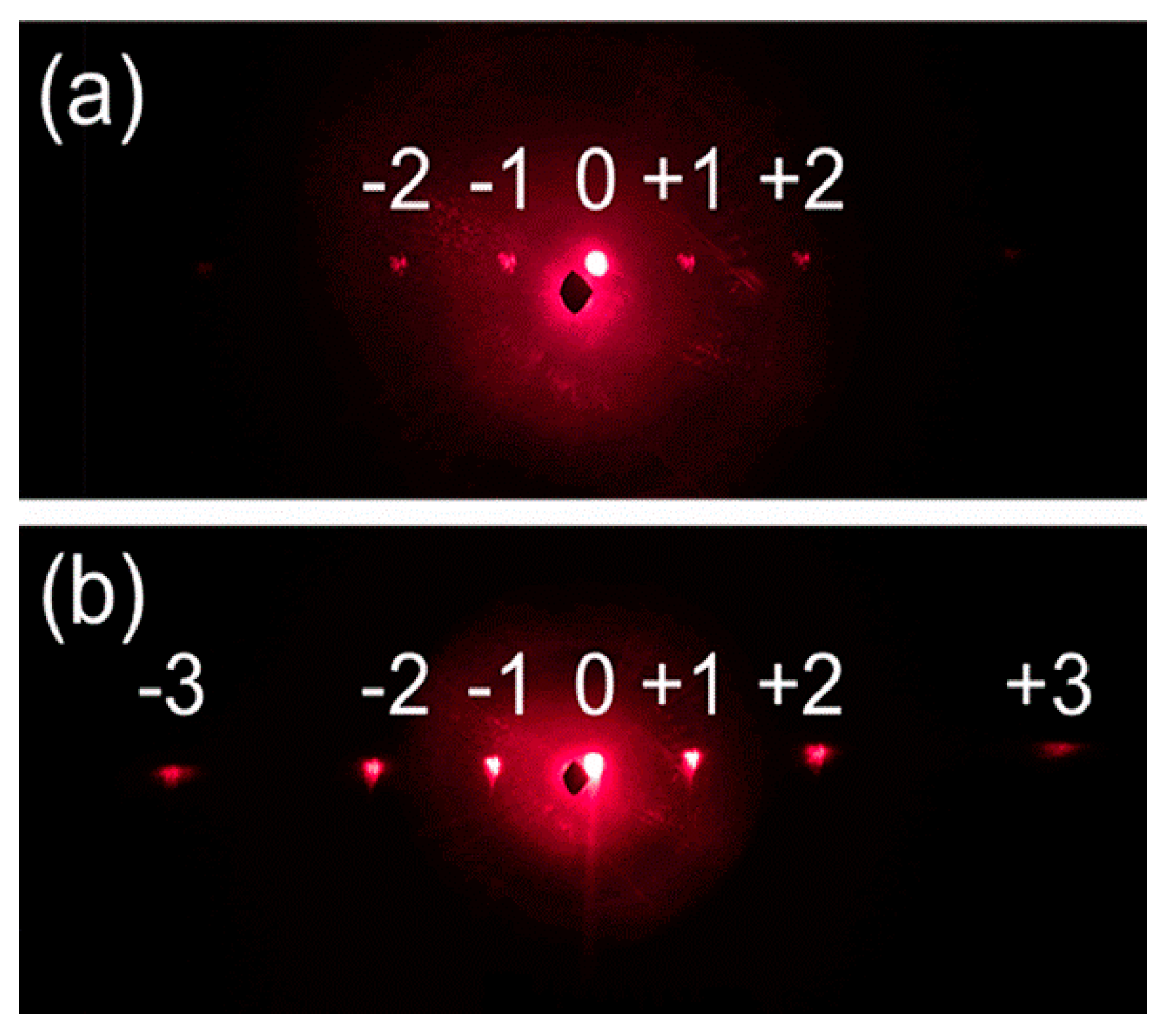

© 2020 by the authors. Licensee MDPI, Basel, Switzerland. This article is an open access article distributed under the terms and conditions of the Creative Commons Attribution (CC BY) license (http://creativecommons.org/licenses/by/4.0/).
Share and Cite
Yang, S.-N.; Liu, X.-Q.; Zheng, J.-X.; Lu, Y.-M.; Gao, B.-R. Periodic Microstructures Fabricated by Laser Interference with Subsequent Etching. Nanomaterials 2020, 10, 1313. https://doi.org/10.3390/nano10071313
Yang S-N, Liu X-Q, Zheng J-X, Lu Y-M, Gao B-R. Periodic Microstructures Fabricated by Laser Interference with Subsequent Etching. Nanomaterials. 2020; 10(7):1313. https://doi.org/10.3390/nano10071313
Chicago/Turabian StyleYang, Shuang-Ning, Xue-Qing Liu, Jia-Xin Zheng, Yi-Ming Lu, and Bing-Rong Gao. 2020. "Periodic Microstructures Fabricated by Laser Interference with Subsequent Etching" Nanomaterials 10, no. 7: 1313. https://doi.org/10.3390/nano10071313
APA StyleYang, S.-N., Liu, X.-Q., Zheng, J.-X., Lu, Y.-M., & Gao, B.-R. (2020). Periodic Microstructures Fabricated by Laser Interference with Subsequent Etching. Nanomaterials, 10(7), 1313. https://doi.org/10.3390/nano10071313





